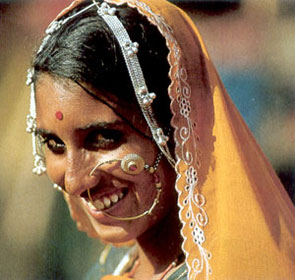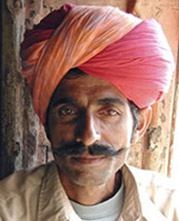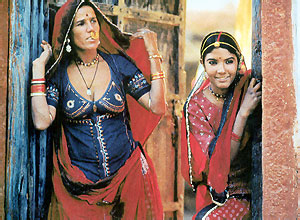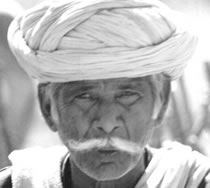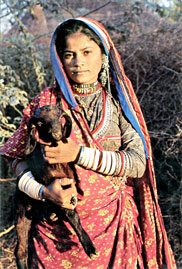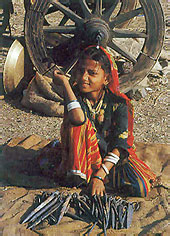Rural Rajasthan - Folk Tribes of Rural Rajasthan |
||||||||||||||
|
||||||||||||||
|
Folk Tribes of Rural Rajasthan |
||||||||||||||
|
||||||||||||||
| Various Folks | ||||||||||||||
|
||||||||||||||
| Rajputs | ||||||||||||||
|
||||||||||||||
| Brahmins | ||||||||||||||
|
The Brahmins, who have commandeered the top social rank for themselves in the rest of the country, found themselves at a status that was equal to that of the Rajputs. These kingdoms were often at war and the region was at the mercy of looters and invaders. Therefore, the total sovereignty of the Rajputs had to be accepted, if only for the protection that they were able to offer. The Brahmins served in the royal courts and worked in departments of administration, though their main task was to administer the souls of the people they served. They were priests in the temples and offer the prayers to please the gods. Also, while the Brahmins were great orthodox, the Rajputs believed in animal sacrifices for their gods. |
||||||||||||||
| Jats | ||||||||||||||
|
The Jats also called as Choudhary, occupy a prominent position in Rajasthan being the largest group in this region. They are divided into 12 chief clans and about 230 minor gotras. Though the origin of the Jat tribe is shrouded in mystery, but the Jats still betray tribal traits. Agriculture has always been the main occupation of the Jats but now they are also working in other fields like military and police. They are also well represented in government civil services. "Men may come and men may go, but I go on forever," is a well known Jat proverb. The Jats are brave and hardworking who possess both the desire and ability to rule. Many Jats were recruited into the Indian Army during World War I. Before that, they served as fighters in the Persian army. A large number of Jats also served in the Indian Armed Forces and form one of the largest ethnic groups in the army (The Jat Regiment). Bharatpur, Deeg and Dholpur in Rajasthan were ruled by Jat rulers. The Green Revolution brought considerable prosperity to the Jats in the late 1960 and 1970. |
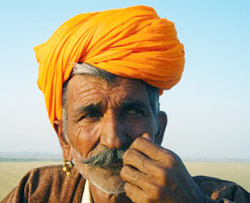 |
|||||||||||||
|
||||||||||||||
|
||||||||||||||
| violent and aggressive in protecting trees and animals. They are pure vegetarian and nature worshipper. They treat black buck as a sacred animal. They bury dead bodies instead of burning them to save forest wood. The bishnois lives in the neighbouring states of Uttar Pradesh, Madhya Pradesh, Gujarat and Haryana. Bisnois often live in little hamlets called `Dhannis', with just a few round huts with intricate thatched roofs. They scrub the floors of the huts and courtyards, and cook in earthen ovens. They are the most colourful and exotic wanderers in the ruins of desert, who keep moving from one village to another in search of work and livelihood. They normally wear white shirt, dhoti and turban. The Bishnoi women wear attractive attire of vibrant colors such as red and orange, silver trimmings and the gorgeous jewellery like heavy nose rings, earrings, bangles, anklets and necklaces. | ||||||||||||||
|
||||||||||||||
|
part of the earlobes and bangles. The literacy rate of the Bhils, particularly the women, is very lowest due to which they are exploited and worked as bonded labour. Marriages of love, as opposed to arranged marriages which are the norm in India, are condoned. The Baneshwar Fair is a Bhil festival which is held near Dungarpur in the month of January or February each year, and large number of Bhils gather for several days of singing, dancing and worship. Holi is another important time for the Bhils. |
||||||||||||||
| Minas | ||||||||||||||
|
||||||||||||||
| Gujars | ||||||||||||||
| The Gujars inhabited the area in the north of the Aravallis, stretching from Bikaner to Bharatpur and Jaipur regions, where they are cultivators, cattle breeders and herdsmen. They are also located in Ajmer region and in the Mewar plains beyond. They are found in large numbers in the northern part of Karauli region. | ||||||||||||||
| Tribals | ||||||||||||||
|
The tribals are believed to be the original inhabitants of the hilly tracts of the desert of Rajasthan. They are known as carefree folks for their skills at both warfare and the zest with which they celebrate their festivals and conduct their lives. They were known as criminal tribes by the British. |
||||||||||||||
|
||||||||||||||
| Gavarias | ||||||||||||||
| The Gavaria is a community traditionally associated with rope making in the countryside. Their community life is strictly governed by their panchayats. The consolidated panchayat of the whole region functions as the Supreme Court which sits in a grand style in a circular ring to hear the appeals from the lower panchayats. Its decisions are the last word for the members of the community. While the males mostly look after the rope-making activity, the females attend to its marketing. The women move from one village to another with a pony and a typical basket in which they keep their merchandise which comprises of ropes and small articles like mirrors, combs, bangles and tiny trinkets. The basket called odi is an important item amongst the household goods, an article which the parents must give to the daughter at the time of her wedding. Their marriages are generally contracted through what is called the ata-sata system where the daughter of a family is married in the same family as the son. | ||||||||||||||
| Banjaras | ||||||||||||||
| The Banjaras are nomadic people who travel with bullock carts or oxen-laden caravan from place to place and continue their travelling wherever their caravans were in demand. In the past, there were usually bullock-caravans in thousands or lakhs. Since they performed a very important role, armies rarely troubled them. Now, the modern means of transport have robbed them of their livelihood and they have now settled into a semi-nomadic existence, doing jobs, entertaining, and farming. | ||||||||||||||
|
Schedule Castes |
||||||||||||||
| Bhands | ||||||||||||||
|
The Bhands are
known for their skillful use of satire, ridicule and sarcasm in exposing
and attacking vices and follies of people. The Bhands have the ability to
retort with immediate wit and humour, and hold a highly scintillating
conversation. |
||||||||||||||
| Bhambis | ||||||||||||||
|
The Bhambis are
also known as the Meghwals. Traditionally, they were associated with the
profession of village watchmen, guides and messengers and also skinners of
dead animals. Now, they are working as agricultural labourers. |
||||||||||||||
| Kolis | ||||||||||||||
|
The Koli
community is said to be one of the original dwellers of the countryside in
Rajasthan and their traditional occupation is weaving. |
||||||||||||||
| Harijans | ||||||||||||||
|
The Harijans
also called as Mehater are sweepers. |
||||||||||||||
| Traders | ||||||||||||||
|
There are two
mercantile communities or traders in Rajasthan which are the Marwaris and
the Jains. The Marwaris arose from the Shekhawati region and served in the
courts of different princely states. They came to be known as Marwaris
when they journeyed along with the armies of Marwar (Jodhpur) to the
eastern parts of the country as large opportunities were present there and
the Marwaris were able to capitalise on them. Most of the major business
and industrialist families are still Marwaris and dominate business in the
country. The Jains deals in wholesale business. The marwaris deals in the
export and import of commodity and played an important role in the overall
economic development of the state. The marwaris have also setup many
schools and colleges, hospitals and clinics. They have also raised per
capita income in Rajasthan and have improved infrastructure by building
good roads and transport system. |
||||||||||||||
| Merchant | ||||||||||||||
|
The merchants
often tended to be richer than the kings they served. Several prime
ministers in the kingdom were Jain merchants. The Marwaris continued to
remain loyal to their princes who had honoured them with the title of
tazimi-sardar, which was given to the very selected people. A
tazimi-sardar was allowed to continue sitting in the presence of the
Maharaja and allowed to wear gold on his feet, a privilege rarely extended
to people outside the immediate circle of the royal family. Jaisalmer's
Guman Chand Patwa was one of the wealthiest merchant of its time, who used
to own more than three hundred trading centers from China to Afghanistan.
The merchants deals in international trade. |
||||||||||||||
| Service People | ||||||||||||||
|
If the Rajputs,
Brahmins, Marwaris and Jains formed the social elite, the role of the
service caste was also not less significant. Especially at the village
level, they create a network of services that the society could depend on
and their services was intended for the society. |
||||||||||||||
| Kumhars | ||||||||||||||
|
The Kumhars are
very important community in the social life of the people of Rajasthan.
They make earthen vessels, pots and pans for domestic use and persian-wheels
for irrigation. The earthen vessels, used on the occasion of wedding, are
ceremonially brought from the Kumhar's residence. One of the section in
the Kumhar community is traditionally engaged in drawing water from the
wells and delivering the same to the people in pitchers which is either
carried by them over their shoulders or through kaawad. They also carry
Paalki, the palanquins to transport people. |
||||||||||||||
| Khatis | ||||||||||||||
|
The Khatis or
Carpenters are the skilled craftsman and construct unique wood items. The
Suthars or Khatis (Carpenter) trace their origin from Vishwakarma. They
are divided into 120 parts and named after their founders or the villages
they belong to. The majority of population belongs to the Jakhra branch
and worship goddess Savitri as their main deity. Some wear the sacred
thread and abstain from liquor and meat and call themselves as
Bamania-Khati. |
||||||||||||||
| Charans | ||||||||||||||
|
The Charans are
historians and the recorders of the real events and commemorators of
personages. The poisoned words of the Charans were dreaded more by the
people, then in authority. Some
of their works afford many valuable data of historical evidence of facts,
incidents, religious opinions and traits of manner of the people living in
the princely days. |
||||||||||||||
| Nais | ||||||||||||||
|
The Nai or barbers are known for their ability to make clever, ironic and
satirical remarks, usually by perceiving and expressing it in a sharp,
spontaneous and surprising manner. Their sarcastic remarks are often
reinforced by short poems, and they amuse and entertain the listeners. The
nai or barbers also cut hairs, give shaves and trim beards. The barbers
also works as messenger and carries invitation and also make Pattal-dona
leaf-plates and leaf-bowls for their clients for use in community feasts.
They are also traditionally associated with odd tasks like ear-cleaning,
boil lancing and shaving corpses before cremation. Nai's wife called Nayan
sever the navel-cord after the birth of a baby and bury the placenta. |
||||||||||||||
| Gadia Lohars | ||||||||||||||
|
||||||||||||||
|
mobile homes, taking shelter within. |
||||||||||||||
|
||||||||||||||




